Kansas
| |
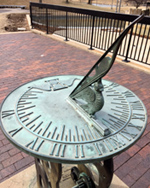 |
Wichita |
Kansas |
USA |
Horizontal Dial |
Dial 281 |
| A bronze dial about 2 feet in diameter that has a simple chapter ring with Roman numerals. The gnomon is an artistic extension of a bird. The sundial sits atop a 30-inch pedestal of open ironwork reminiscent of a clock tower. Cogs put together inside the open structure at the bottom reinforce this impression. All sits on a square concrete dais. |
| |
| |
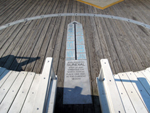 |
Wildwood |
New Jersey |
USA |
Analemmatic Dial |
Dial 914 |
| On the boardwalk, inset into the wood planks is a smooth concrete walkway about 12 inches wide. Months and instructions are given in neat lettering made in the concrete. The hours are done on a half-ellipse using the same smooth concrete, Arabic numbers, and 15-minute time marks (far narrower than a person's shadow). The dial is set for daylight saving time (with no longitude correction). |
| |
| |
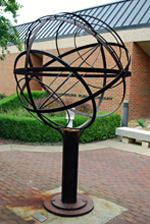 |
Williamsburg |
Virginia |
USA |
Armillary Sphere |
Dial 877 |
| This armillary is constructed of welded carbon steel narrow bands approximately 4-feet in diameter sitting on an iron post about 3-feet high. The equatorial band has no engraved or embossed time marks, but the simple rod gnomon has two side rods. According the the WPL website, "Time on the sundial is read by looking at where the gnomon shadow is cast. This shadow will be the middle, thicker shadow of the three shadow-lines ... Although hours are not marked off on this sundial, you can estimate the time of day by thinking of the gnomon shadow hoop as the clock face and the shadow as the hour hand of that clock." Well, not exactly. The hours are at 15-deg intervals with 12 noon at the bottom of the equatorial band at the intersection of the meridian band. This armillary is more of a sculpture than a timepiece. Yet the armillary has the traditional tropic of Capricorn and Cancer bands as well as Arctic, Antarctic,and horizontal bands. |
| |
| |
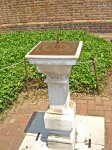 |
Williamsburg |
Virginia |
USA |
Horizontal Dial |
Dial 115 |
| A 14 inch square brass horizontal dial with hour lines and Roman numerals, compass rose and inscriptions honoring John Barrow. A fluted square pillar supports the dial. |
| |
| |
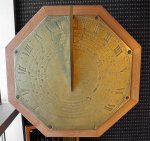 |
Williamsburg |
Virginia |
USA |
Horizontal Dial |
Dial 116 |
| A unique bronze 12-3/8 inch octagonal horizontal dial with one main hour ring for local time and six subsidiary rings that give the time in London, Vienna, Constantinople, Jerusalem, Barbados and Mexico City. The main hour ring shows hours in Roman numerals and ten minute intervals in Arabic numbers; each hour is divided into sixty minute intervals and "fleur-de-lis" decorations are placed at the thirty-minute marks. The subsidiary rings are inscribed with Roman numerals for daylight hours and Arabic numbers for night hours. The presence of subsidiary rings suggests the dial was made with an instructive or "world-view" intent. |
| |
| |
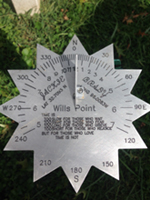 |
Wills Point |
Texas |
USA |
Horizontal Dial |
Dial 884 |
| This starburst sundial is 6-3/4 inches in diameter, made of 1/8 inch aluminum plate. The dial is actually set in a 12-point compass rose, showing the azimuth every 30 degrees. Time marks are every 15 minutes with hours in Arabic numerals. All marking, latitude, longitude, and inscription are engraved into the dial plate. |
| |
| |
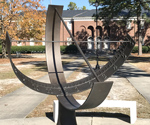 |
Wilmington |
North Carolina |
USA |
Equatorial Dial |
Dial 852 |
| This is a bronze hemispherical equatorial sundial approximately 30 inches in diameter. The wide equatorial band is delineated every quarter hour and has cast Arabic numerals as hour markers from 6am to 6pm. The meridian band is inscribed with markers for the solstices and cross-quarter days. |
| |
| |
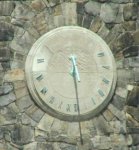 |
Wilmington |
Delaware |
USA |
Vertical Dial |
Dial 320 |
| A round limestone vertical dial about 3 feet in diameter with bronze gnomon. Hours are bronze Roman numerals. No hour lines drawn. The dial is set on the side of a beautiful stone tower. According to a plaque at the tower's base, in 1895 Theodore Leissen recommended a large pavilion and observatory be built on the city's highest hill. At the same time the Water Commission needed a water tower. The plans were merged, resulting in a combine stone water tower 115 feet tall holding half a million gallons and a roofed observatory platform. The dial is on the side of this Rockford Tower. |
| |
| |
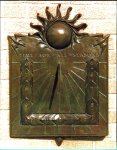 |
Wilmington |
Delaware |
USA |
Vertical Dial |
Dial 609 |
| An 18 x 24 inch cast bronze vertical dial offset from supporting wall by 6.25° to align south. Dial face has hour lines with Arabic numerals and depicts a leaf motif with sun and sun rays and two birds. |
| |
| |
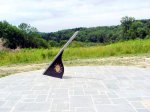 |
Wilmot |
Ohio |
USA |
Horizontal Dial |
Dial 444 |
| The Wilderness Center Sundial is large horizontal dial with a 6-foot steel gnomon approximately 27 inches thick. The base is done in slate with copper numbers. |
| |
| |
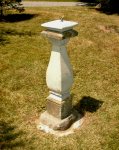 |
Windsor |
Nova Scotia |
Canada |
Horizontal Dial |
Dial 406 |
| A small horizontal dial with an 11-inch square base. The dial was made in 1845, but the original was damaged by vandals. There now exists a fiberglass reproduction of the dial with metal gnomon on a cast cement base. The dial has Arabic numerals indicating 4 a.m. to 8 p.m. and corresponding hour lines. The dial is located on the grounds of the Haliburton House, built in 1836 by Thomas Chandler Haliburton, a justice of the Supreme Court of Nova Scotia and author of "The Clockmaker" stories. |
| |
| |
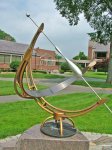 |
Windsor |
Connecticut |
USA |
Equatorial Dial |
Dial 211 |
| Equatorial dial about 5 ft. diameter made of brass and stainless steel The analemma is incorporated into the gnomon compensating for equation of time. Equatorial ring is rotated to compensate for difference in longitude to time zone. Designed and built by Physics/Astor Dept, University of Calgary, Alberta Canada. Dial sits atop a stone plinth marked with Keller's laws. |
| |
| |
 |
Windsor |
Ontario |
Canada |
Vertical Dial |
Dial 639 |
| Two vertical bronze-on-masonry dials on adjacent faces upper faces of a square, 25 foot high tower. Dial faces are aligned approximately SE and SW. A bronze armillary sphere is placed atop the tower. The tower and sundials were designed and built by the Windsor Polish community and dedicated in the Windsor centennial year in memory of M. Kopernik (Copernicus). |
| |
| |
 |
Windsor |
Ontario |
Canada |
Noon Mark or Meridian Dial |
Dial 779 |
| A 12 foot high noon mark dial consisting of two closely spaced triangular vertical plates, a protruding needle and pairs of summer and winter solstice "wings" that together project a shadow onto the surrounding concrete deck within a 40 foot diameter reflecting pool.
When the sun totally illuminates the narrow space between the vertical plates, it is local noon and the shadow cast by the protruding needle points true north. On the summer solstice, the shadow cast by the smaller, upper solstice wings will be at its narrowest width. On the winter solstice, the shadow cast by the lower solstice wings will be at its narrowest width. |
| |
| |
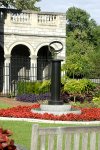 |
Windsor |
Ontario |
Canada |
Armillary Sphere |
Dial 780 |
| A simple armillary dial about two feet in diameter with an equatorial hour ring. The dial is mounted atop a tall, black cylindrical pillar within a formal garden of Willistead Manor. The manor is open to the public on selected days. |
| |
| |
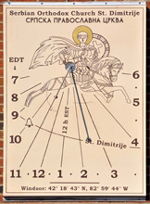 |
Windsor |
Ontario |
Canada |
Vertical Dial |
Dial 874 |
| A vertical stone sundial made of white quartzite approximately in a 6 x 4 feet rectangle. The dial face includes engraved hour lines from 7am to 6pm in Arabic hour numerals for Eastern Daylight Time and an elegant engraved outline of St. Dimitrije based on a partially preserved 14th century fresco of the Saint in St.Mary's Church, Donja Kamenica, Serbia. Rather than summer and winter solstice lines, a single hyperbola indicates the route of the gnomon shadow's tip on 8 November - the day of St.Demetrius (St. Dimitrije). In fact, the gnomon is represented at St. Demetrius' sword (or more appropriately, his spear). A small bell is engraved at 10am indicating the time of morning liturgy. At about 11:15 if you look closely, you can see the subnode point (polos montaza) of the gnomon tip used for alignment during construction. |
| |
| |
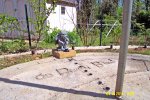 |
Winston-Salem |
North Carolina |
USA |
Analemmatic Dial |
Dial 709 |
| A 23.5 foot major axis analemmatic dial with a 10 foot tall movable steel vertical gnomon. Hours are marked by numerals on solar-powered lamps on the ellipse at the perimeter bush line. The concrete dial face consists of an 8 foot dais that displays the EOT and hosts a handsome gargoyle.
This private dial is available for viewing by contacting the owner. |
| |
| |
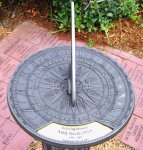 |
Winter Park |
Florida |
USA |
Horizontal Dial |
Dial 515 |
| A 12-inch diameter horizontal bronze dial set on a simple fluted pedestal. The dial face includes hour lines with half hour and ten minute marks and a central compass rose. The gnomon includes an adjusting screw allowing the gnomon angle to be set to the latitude angle.
The dial is located in a small garden area of an elementary school and includes a nearby flagstone bench. The walkway around the dial is of red bricks inscribed with the names of graduating students. Students learned of the death of a 9 year old classmate and through their fundraising efforts helped establish this memorial dial in their schoolyard.
A visitor's pass is required from the administration office before viewing. |
| |
| |
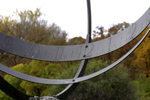 |
Winterthur |
Delaware |
USA |
Armillary Sphere |
Dial 806 |
| The 59" armillary is located in the Sundial Garden, designed by Landscape Designer Marian Coffin for Henry Francis DuPont for the family's former tennis court in 1955. It features an antique armillary sundial weighing 70 pounds. It was collected by the DuPont family between 1850-1920. |
| |
| |
 |
Winterthur |
Delaware |
USA |
Horizontal Dial |
Dial 807 |
| A bronze horizontal sundial about 18 inches in diameter. The Arabic hour numbers range from 4am to 8pm, with time delineated into half, quarter, and eighth hours. A side photo of the gnomon shows it is set for about 53° and the top-down photo of the dial (corrected for perspective) confirms this. A DuPont purchase in England? |
| |
| |
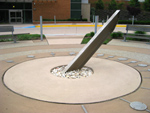 |
Woodbridge |
Virginia |
USA |
Horizontal Dial |
Dial 861 |
| This horizontal dial sits on a low concrete dais 13 feet in diameter. At the interior is an oculus 3 feet in diameter with loose gravel from which a 10-inch I-beam gnomon emerges. The I-Beam extends approximately 4 feet into the air with the north end cut vertical to the ground and then canted back creating a graceful taper on the underside. The dais concrete is of two colors: an inner pink ring 9 feet in diameter and an outer earth-toned ring that serves as a 2 foot wide chapter ring. |
| |
| |
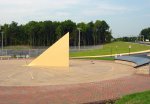 |
Woodbridge |
Virginia |
USA |
Horizontal Dial |
Dial 534 |
| A large 62 foot diameter horizontal sundial of grey concrete and brick with a 10 foot high steel gnomon. The dial was designed to memorialize the victims of the 9/11/2001 terrorism and includes four inlaid plaques on which the gnomon shadow falls at 8:45, 9:03, 9:37 and 10:07 AM, the times of the four air crashes. Hour markers are inset brass Roman numerals. The hour lines and NESW compass rose are 2 inch wide inset brass strips. |
| |
| |
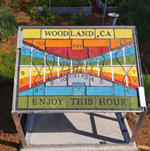 |
Woodland |
California |
USA |
Polar Dial |
Dial 1095 |
| It is a polar dial using a rod gnomon. Using a template from Shadows software, the dial is made of handmade ceramic tiles mounted on an aluminum bar frame anchored to a concrete base. Brass borders define winter and summer solstice declination lines, and an aluminum bar defines the E-W equinox declination. Copper analemmas define the sun’s annual path at 7:30/8:30 PST/PDT and hourly until 5/6PM. Metal balls along the analemmas are placed the 1st of each month. Black declination lines mark the ancient Babylonian Zodiacal signs, designated by different colors. Hours are numbered for PST and PDT. Standard time on the hour, accurate to 1 minute, is read on the tile surface when the gnomon shadow is just under the analemma for that hour. The 1st of each month is marked on tiles in early AM and late PM hours, guiding which side of the analemma is used. |
| |
| |
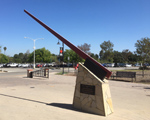 |
Woodland Hills |
California |
USA |
Horizontal Dial |
Dial 1062 |
| This is a simple, but elegant horizontal dial. A large gnomon pointer sits on a trapezoidal pedestal, creating a large horizontal dial. Surrounding it on a concrete plaza are circular hour marks with standard and daylight saving time. |
| |
| |
 |
Woods Hole |
Massachusetts |
USA |
Pillar Dial |
Dial 176 |
| Stone pillar. Brass EOT graph Four-sided column. Dial on each face, with stone sphere containing a polar axis mounted on the top. Known as the Yalden dial. North gnomon has been placed incorrectly since at least the early 70's. |
| |
| |
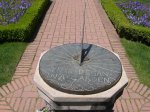 |
Woodside |
California |
USA |
Horizontal Dial |
Dial 558 |
| A 15 inch diameter well-patinaed horizontal bronze dial on a stone pillar. This dial was designed for a different location. The hour lines are cut for 50? N; the gnomon angle is 46.5? and is miss-located on the dial face. |
| |
| |
|
Woodstock |
Vermont |
USA |
Analemmatic Dial |
Dial 265 |
| ca 18' ft Concrete blocks Composed of rectangular cement blocks set in a semi-circle with the hours of the day etched into the side of each block. Facing these is a cement walkway with the initials of each month of the year. |
| |
| |
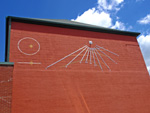 |
Wooster |
Ohio |
USA |
Vertical Dial |
Dial 799 |
| A vertical dial on a 15 x 40 foot section of a second story brick wall declining 11° east. The gnomon, hour lines and 7 am to 4 pm Arabic hour numerals are aluminum. |
| |
| |
|
Wooster |
Ohio |
USA |
Horizontal Dial |
Dial 196 |
| Brass or bronze Gift to the College from the Class of 1907. On S side of gnomon, an embossed figure, possibly Father Time with scythe. Mounted atop a carved stope base with motto, "United in time, parted in time to be reunited when time shall be no more." |
| |
| |
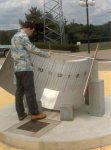 |
Worcester |
Massachusetts |
USA |
Equatorial Dial |
Dial 95 |
| ca 6' segment of cylinder, approx 3' high Metal Gnomon is intentionally omitted. Visitor stands centered in the curve of the cylinder and places finger on crossbar as directed. Shadow of finger indicates the time. |
| |
| |
 |
Worcester |
Massachusetts |
USA |
Equatorial Dial |
Dial 312 |
| A Victor E. Edwards bronze equatorial sundial. It has an unusual crescent shaped arm with notch at the upper end. The arm is rotated until sunlight through the notch strikes an analemma on the lower inner curve of the crescent. Time is then read on a circular dial from an "hour hand" pointer extending from the base of the crescent. |
| |
| |
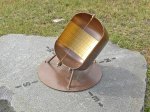 |
Wynndel |
British Columbia |
Canada |
Cylindrical Dial |
Dial 760 |
| A ring equatorial dial built inside a cross-sectioned propane LPG tank. The equatorial surface has an inset plaque that shows EOT corrected time and includes declination lines for date shown by the shadow of the nodus on the polar gnomon wire. Dial sits on a granite block pedestal that shows cardinal directions. |
| |
| |
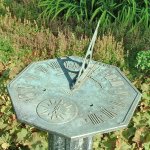 |
Yellow Springs |
Ohio |
USA |
Horizontal Dial |
Dial 628 |
| A 14.5 inch octagonal bronze horizontal dial on a cast iron pedestal. Dial was originally made for the present owner's great grandfather in the early 1900's. Face has Roman numerals with hour and half-hour markers. Compass rose cast in face aligns to magnetic north and stars of Big Dipper are shown. Dial was made originally for location near Northampton, Pennsylvania in early 1900's and is marked "41° LATITUDE." At present location, dial is tipped 1.2° for latitude correction. Two time arcs are shown on the dial face: "LONG DAY" arc extends from 5 AM to 7 PM; "SHORT DAY" arc extends from 7:30 AM to 4:30 PM. |
| |
| |
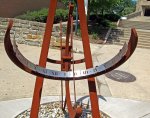 |
Youngstown |
Ohio |
USA |
Equatorial Dial |
Dial 720 |
| A nearly 10 foot high steel equatorial dial with a 30 inch diameter stainless steel hour ring including cut-out diamonds for hour and half-hour marks and Roman hour numerals. The hour ring can be adjusted for EST or EDST and can be set to include longitude correction. The mild steel sculpture has naturally weathered.
Located outside the YSU Ward Beecher Planetarium, the dial is dedicated to the memory of Richard Pirko, long-time planetarium engineer and show producer, whose dream was to have a sundial outside the planetarium. A nearby bronze plaque dedicates the dial. |
| |
| |
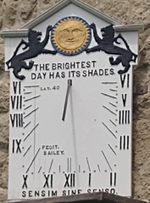 |
Youngstown |
Ohio |
USA |
Vertical Dial |
Dial 1033 |
| Since the wall of the house/museum does not face true south, this vertical dial is set atop a plinth mounted midway up the south-west wall. The 2 x 4 foot (61 x 122 cm) dial face appears to be painted white wood ornamented with a gold face of the sun held by two black heraldic lions. The gnomon is a simple rod and the dial is delineated for due south with "Lat 40°" painted on the dial face. However, the building is at 41° latitude. Along the periphery of the dial face painted in black are hours are marked in Roman numerals from VI to VI with lines showing hour lines and shorter lines for the half-hours. Quarter hours are marked with black dots. The sundial was restored within the past ten years. |
| |
| |
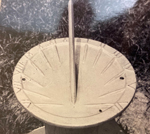 |
Ypsilanti |
Michigan |
USA |
Horizontal Dial |
Dial 1086 |
| This is the original horizontal dial and gnomon of 1909, cast in iron as a gift from the Class of 1908 (then known as the Michigan State Normal School ). This sundial was originally located on the west side of the sidewalk coming from the main south entrance of Serzer Observatory on the Eastern Michigan University campus, now the location of the EMU "Sesquicentennial Sundial". [See NASS Dial #346] This original dial is about 12 inches (30cm) with Roman hour marks from 6am to 6pm on the edge of the dial. Hour lines extend from the edge to about half way to the gnomon foot. |
| |
| |
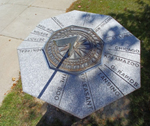 |
Ypsilanti |
Michigan |
USA |
Horizontal Dial |
Dial 346 |
| The original horizontal dial and gnomon of 1909 was cast in iron as a gift from the Class of 1908 (then known as the Michigan State Normal School ). This dial is now in the EMU archives.[See NASS Dial #1086] The current sundial was placed in the same spot in front of Serzer Observatory in the 1960's, but went missing after a broken gnomon was sent for repair, and was lost for 30 years. In 1999, during the sesquicentennial celebration of the university, EMU had the sundial restored by Arnets Becker Burrell Monuments of Ann Arbor. They also had the sesquicentennial logo added to the pedestal. The restoration was funded by the Serzer family. The elegant weathered brass and copper dial is now known as the "Sesquicentennial Sundial". Surrounding the dial are lines in the granite plinth to the cities of Montreal, Detroit, Boston, New York, Whittington DC, Toledo, New Orleans, St. Louis, Chicago, Kalamazoo, Grand Rapids, Lansing, and MT Pleasant. The original Class of 1908 4-ft (1.2m) granite pedestal still holds the sundial, including its mark of "150 years". |
| |
| |
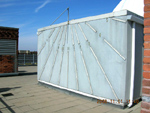 |
Ypsilanti |
Michigan |
USA |
Vertical Dial |
Dial 379 |
| A 10x15 foot vertical wall dial mounted on a stucco wall. The dial is tile with an aluminum gnomon. This dial atop Sherzer observatory has been relined and renumbered several times. The dial has a brass gnomon. The newer campus landmark is visible from as far away as Wasahtenaw Avenue. The dial was designed and built by Thad Weakley as an independent study project under professor Dr. Jon K Wooley (it earned Thad 3 credits!) |
| |
| |
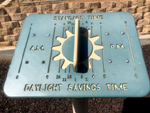 |
Yucaipa |
California |
USA |
Polar Dial |
Dial 1056 |
| This polar dial on a plate 24 inches wide by 14.5 inches tall (61 x 37 cm) and is on a stand about 50 inches (127cm) high. Shows both Pacific Standard (7AM - 5PM) and Daylight Saving Time with hour marks only. Sun motif in the center below a long gnomon. |
| |